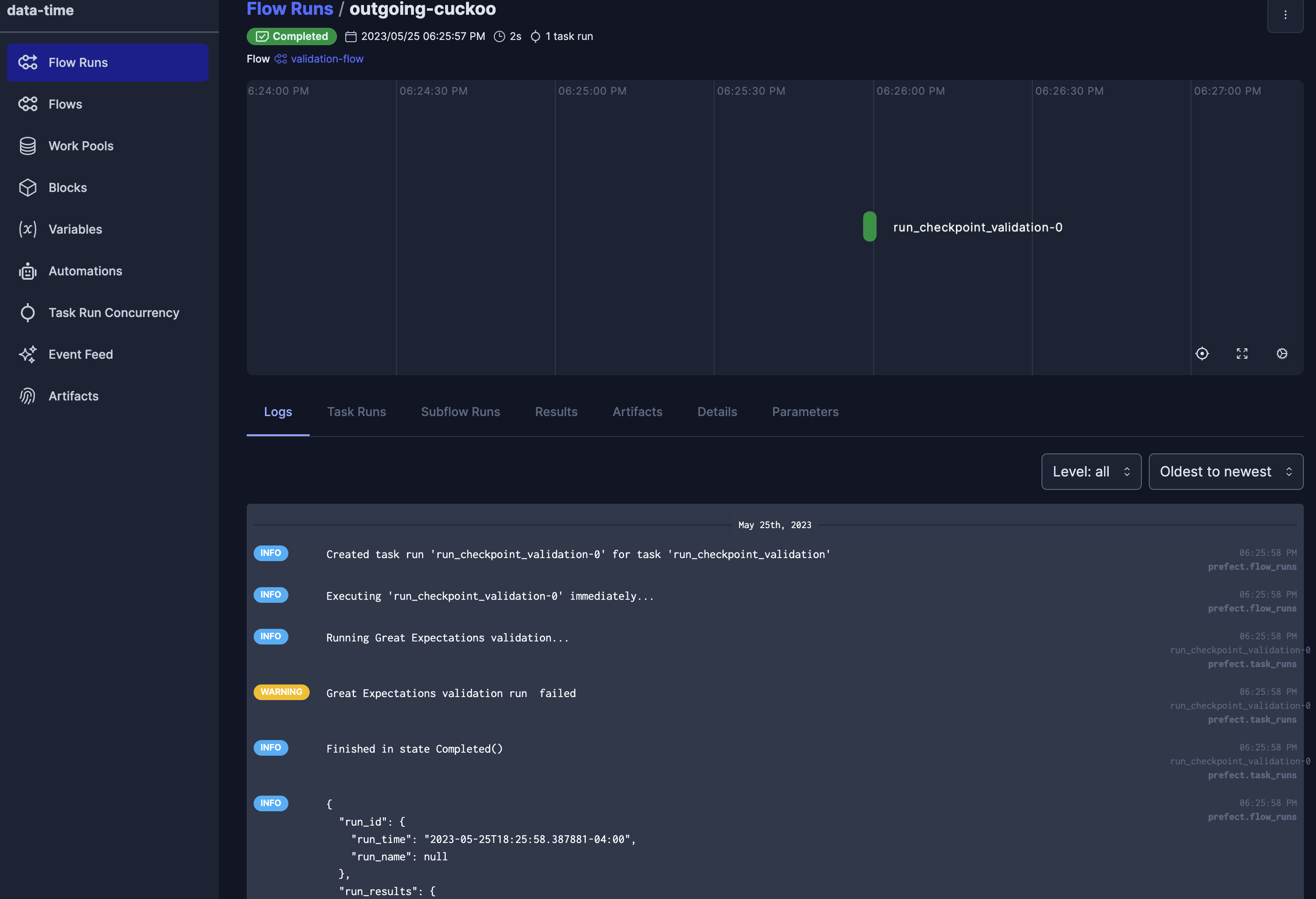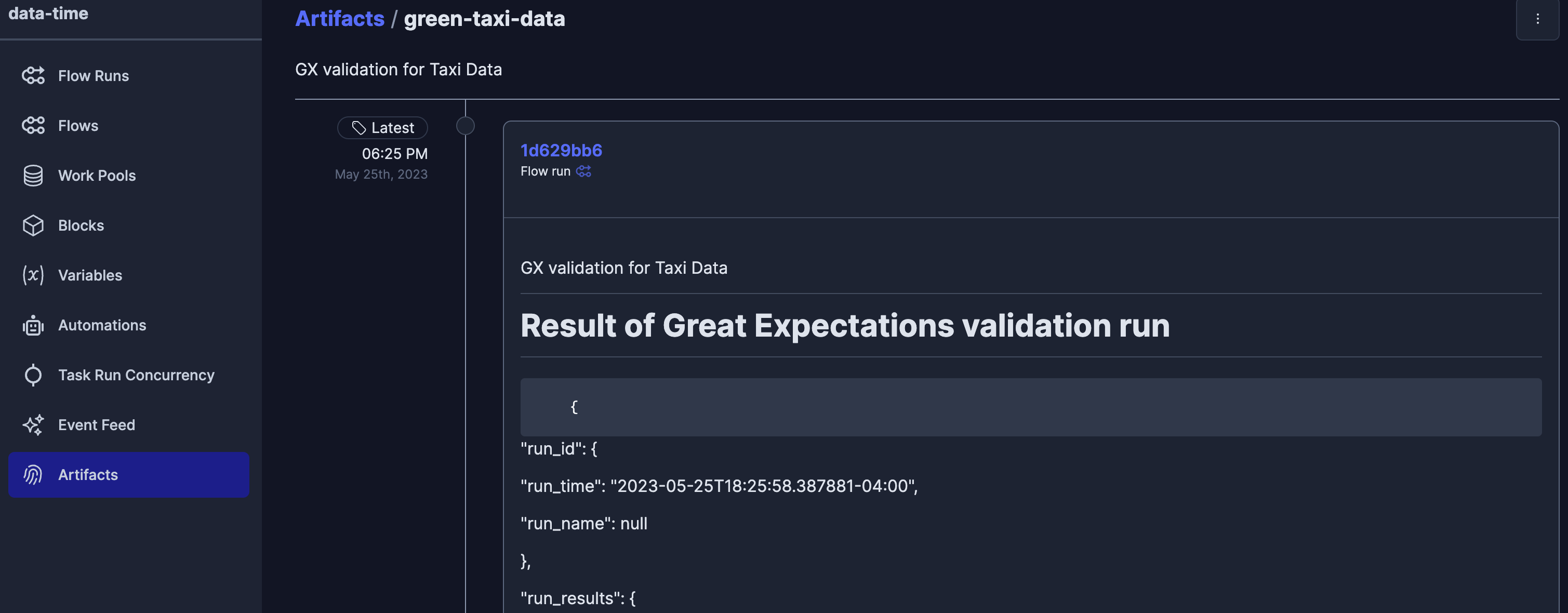How to Use Great Expectations with Prefect
This guide will help you use Great Expectations with Prefect.
Prefect is a workflow orchestration and observation platform that enables data engineers, ML engineers, and data scientists to stop wondering about their workflows. The Prefect open source library allows users to create workflows using Python and add retries, logging, caching, scheduling, failure notifications, and much more. Prefect Cloud offers all that goodness plus a hosted platform, automations, and enterprise features for users who need them. Prefect Cloud provides free and paid tiers.
Prefect can be used with Great Expectations validations so that you can be confident about the state of your data. With a Prefect deployment, you can productionize your workflow and run data quality checks in reaction to the arrival of new data or on a schedule.
Doing it
Install
Install the Great Expectations, Prefect, and prefect-great-expectations libraries into the same Python virtual environment.
pip install great_expectations prefect prefect_great_expectations
If you have any issues installing Prefect, check out the Prefect installation docs.
Create an Expectation Suite and Checkpoint
Here's an example of a script to create an Expectation Suite and Checkpoint. This script is based on the Great Expectations Quickstart.
import great_expectations as gx
def create_expectation_suite_and_checkpoint():
"""Create a DataContext, connect to data, create Expectations, create and return a checkpoint."""
context = gx.get_context()
validator = context.sources.pandas_default.read_csv(
"https://raw.githubusercontent.com/great-expectations/gx_tutorials/main/data/yellow_tripdata_sample_2019-01.csv"
)
validator.expect_column_values_to_not_be_null("pickup_datetime")
# this expectation will fail
validator.expect_column_values_to_be_between(
"passenger_count", min_value=1, max_value=5
)
# checkpoints are reusble and only need to be created once
checkpoint = gx.checkpoint.SimpleCheckpoint(
name="taxi_check",
data_context=context,
validator=validator,
)
return checkpoint
Create a Prefect flow
Like Great Expectations, Prefect is a Pythonic framework. In Prefect, you bring your Python code and sprinkle in task and flow decorators to gain observation and orchestration capabilities.
Let's add a second function that we'll decorate with a Prefect flow decorator. Our flow function uses the run_checkpoint_validation task from the prefect_great_expectations library. This prebuilt function is a Prefect task that runs a Great Expectations validation. The run_checkpoint_validation can take a Great Expectations checkpoint as an argument.
from prefect import flow
from prefect_great_expectations import run_checkpoint_validation
@flow
def validation_flow(checkpoint):
"""Creates a task that validates a run of a Great Expectations checkpoint"""
res = run_checkpoint_validation(checkpoint=checkpoint)
return
Finally in our script, let's call our functions.
if __name__ == "__main__":
checkpoint = create_expectation_suite_and_checkpoint()
validation_flow(checkpoint=checkpoint)
Note that the second expectation will fail because the passenger_count column has some 6 values in the data. That's intentional so that we can see a failure example. Here's the output in our terminal window.
18:00:41.816 | INFO | prefect.engine - Created flow run 'unyielding-husky' for flow 'validation-flow'
18:00:43.847 | INFO | Flow run 'unyielding-husky' - Created task run 'run_checkpoint_validation-0' for task 'run_checkpoint_validation'
18:00:43.849 | INFO | Flow run 'unyielding-husky' - Executing 'run_checkpoint_validation-0' immediately...
18:00:44.786 | INFO | Task run 'run_checkpoint_validation-0' - Running Great Expectations validation...
...
18:00:45.057 | ERROR | Task run 'run_checkpoint_validation-0' - Encountered exception during execution:
...
raise GreatExpectationValidationError(result)
prefect_great_expectations.validation.GreatExpectationValidationError: Great Expectations Validation failed. Check result on this exception for more details.
18:00:46.423 | ERROR | Task run 'run_checkpoint_validation-0' - Finished in state Failed('Task run encountered an exception: prefect_great_expectations.validation.GreatExpectationValidationError: Great Expectations Validation failed. Check result on this exception for more details.\n')
18:00:46.424 | ERROR | Flow run 'unyielding-husky' - Encountered exception during execution:
18:00:46.916 | ERROR | Flow run 'unyielding-husky' - Finished in state Failed('Flow run encountered an exception. prefect_great_expectations.validation.GreatExpectationValidationError: Great Expectations Validation failed...
Avoid raising an exception on validation failure
If we want to avoid raising an exception when the validation fails, we can set the raise_on_result argument to False in the run_checkpoint_validation task.
@flow
def validation_flow(checkpoint):
"""Creates a task that validates a run of a Great Expectations checkpoint"""
res = run_checkpoint_validation(
checkpoint=checkpoint, raise_on_validation_failure=False
)
return
Now when we run our script we don't get an exception.
18:06:03.007 | INFO | prefect.engine - Created flow run 'affable-malamute' for flow 'validation-flow'
18:06:03.624 | INFO | Flow run 'affable-malamute' - Created task run 'run_checkpoint_validation-0' for task 'run_checkpoint_validation'
18:06:03.626 | INFO | Flow run 'affable-malamute' - Executing 'run_checkpoint_validation-0' immediately...
18:06:03.880 | INFO | Task run 'run_checkpoint_validation-0' - Running Great Expectations validation...
...
18:06:04.138 | WARNING | Task run 'run_checkpoint_validation-0' - Great Expectations validation run failed
18:06:04.298 | INFO | Task run 'run_checkpoint_validation-0' - Finished in state Completed()
18:06:04.401 | INFO | Flow run 'affable-malamute' - Finished in state Completed('All states completed.')
For more information about the run_checkpoint_validation task, refer to the prefect-great-expectations documentation.
Log prints for more information
In the example above, we don't see all the relevant info for our validation failure. Let's print information about our validation results and log that information by passing log_prints=True to the flow decorator.
@flow(log_prints=True)
def validation_flow(checkpoint):
"""Creates a task that validates a run of a Great Expectations checkpoint"""
res = run_checkpoint_validation(
checkpoint=checkpoint, raise_on_validation_failure=False
)
print(res)
return
Now we can see lots of relevant information in our terminal window, including the following.
...
"partial_unexpected_counts": [
{
"value": 6,
"count": 20
}
...
Looks like we have 20 rows with a 6 in the passenger_count column.
Add artifacts
If we fire up a locally hosted Prefect server or log in to our Prefect Cloud account, we can see the same information in the Prefect UI. In addtion, if we log in to Prefect Cloud we can create an artifact to share with our Prefect workspace collaborators. Let's do that now.
- Head over to https://app.prefect.cloud/ and sign up for a free account or log in to your existing account.
- Authenticate your command line client with
prefect cloud login. - Create an artifact to share your Great Expectations validation results with your collaborators.
Prefect artifacts will persist the validation results from a flow run and display them in the UI. Let's create a Markdown artifact with the validation results.
from prefect.artifacts import create_markdown_artifact
@flow(log_prints=True)
def validation_flow(checkpoint):
"""Creates a task that validates a run of a Great Expectations checkpoint"""
res = run_checkpoint_validation(
checkpoint=checkpoint, raise_on_validation_failure=False
)
create_markdown_artifact(
f"""# Result of Great Expectations validation run
{res}
""",
description="GX validation for Taxi Data",
key="green-taxi-data",
)
return
The UI gives you lots of visibilty into the state of your flow runs.

Your artifact displays validation results for human consumption.

Alternatively, you could share a link to your Great Expectations Data Docs in an artifact.
Wrap
You've seen how to use Prefect with Great Expectations.
Where to go from here
Prefect deployments allow you to run your flow in response to events such as the arrival of new data. You can also run on many types of schedules and on the infrastructure of your choice.
There's lots more to explore for additional observability and orchestration with Prefect.
Happy engineering!